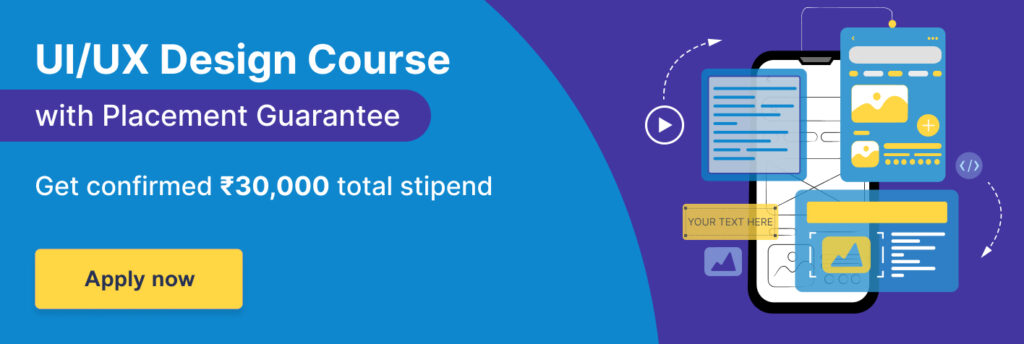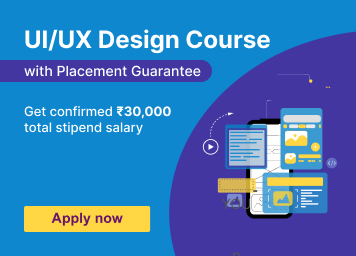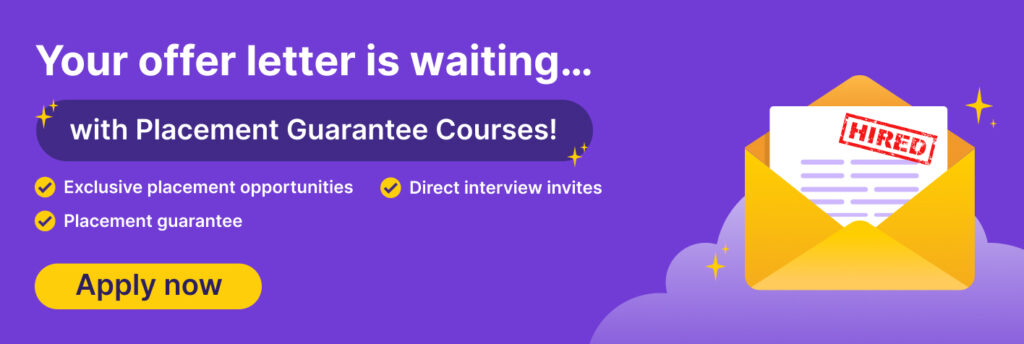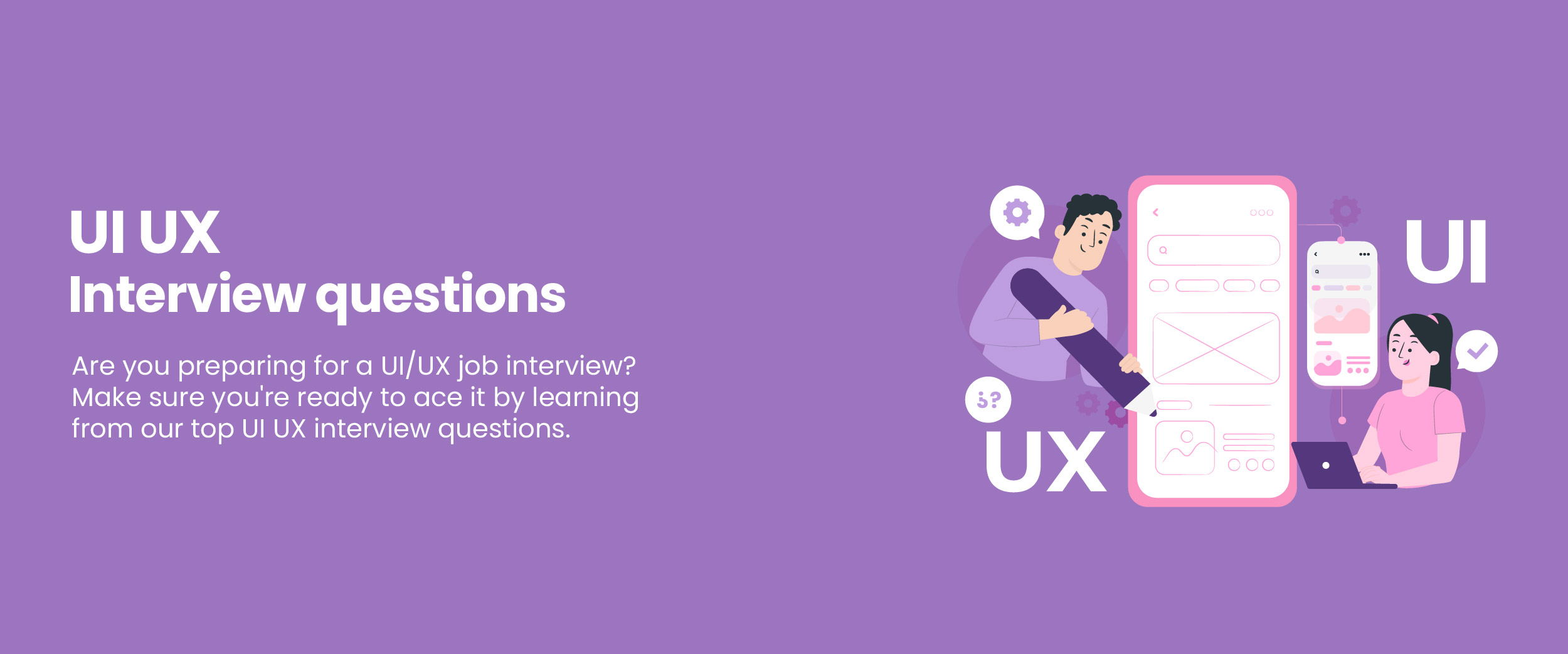Top 45+ UI UX Interview Questions And Answers In 2025
Did you know an average UI UX designer’s salary in India ranges from ₹4,93,888 to ₹10,00,000 annually? The field of UI UX is on the rise and so is the competition. Therefore, to become a successful UI UX designer, you need to stand out from the crowd. To help you get through the interview process, here are some common UI UX interview questions with answers.
UI UX Designer Interview Questions for Freshers
To start your career as a UI UX designer, you need to know some basic questions. Following are some questions that will help you crack the interview.
Q1. What is your understanding of UI UX design?
This is one of the most common UI UX interview questions for freshers. UI UX designs are designed by understanding customer behavior patterns while keeping core design principles in mind. Designers focus on improving the UI without compromising on visual aesthetics or product functionality.
Q2. Can you explain the concept of information architecture in UX design?
Information architecture is the structure of information within a product or system. It involves designing, navigating, and categorizing content to ensure responsive and efficient user experiences. It has an important role in UX design as it helps users to find information easily, understand the relationships between different elements, and navigate through the product seamlessly.
Get a confirmed ₹30,000 total stipend and secure your future with our UI UX design course with placement today!
Q3. What has been your most successful project?
With this question, you can impress the interviewers! You can tell them about the projects you have done. You can even present new ideas to spark curiosity in the interviewer.
Q4. Where do you find inspiration and what are your long-term goals?
I find inspiration from multiple aspects such as user research findings or current trends within the industry’s dynamic landscape. My long-term goals are to continuously improve my skills, contribute to impactful and user-centric design projects, and strive to create intuitive and delightful experiences that positively impact people’s lives.
Q5. How do you handle the pressure?
Interviewers ask this UI UX interview question to see if you will be a good fit for the company. So, you can tell them about your previous experiences where you handled multiple tasks, along with the results.
Q6. What design tools do you use?
You can mention various design tools, like Adobe Xd, Figma, Sketch, UXPin, Slickplan, Axure, or others.
Q7. What do you mean by Design Thinking?
You can frame your answer this way:
- Empathize: Understanding the problem.
- Define: Seeing what the problem is and then elaborating more on it.
- Ideate: Coming up with ideas related to the problem’s solutions.
- Prototype: Present new features and solutions.
- Test: Once everything is done, test it.
Q8. Tell us the kind of features that you add to your design.
The answer to this question may vary from person to person. However, you can talk about these features in detail:
- Target market
- Target market goals
- Resolving the main issues


Q9. What is universal design?
A universal design is understandable, usable, and accessible to everyone, regardless of their knowledge and age.
Q10. How can you know that your design is successful?
By analyzing the metrics, such as clicks, conversations, time-on-page, bounce rates, and others.
Q11. How can a product be accessible to differently-abled people?
A product can be made accessible to differently-abled people by:
- Ensuring proper color contrast, the right fonts, and alternative text for images to assist users with visual impairments.
- Providing keyboard navigation and avoiding reliance on mouse interactions for individuals with motor disabilities.
- Including closed captions and transcripts for multimedia content to accommodate users with hearing impairments.
Q12. How can you conduct UX evaluation?
Some methods to conduct UX evaluation are:
- Aesthetics scale
- Audio narrative
- Controlled observation
- Emotion cards
- Living lab method
- Product personality assignment
You can opt for a UI UX course to get a better understanding of UI UX and increase your chances of getting a good job in this field.
UI UX Designer Interview Questions for Intermediate Candidates
Now, let’s look at some UI UX designer interview questions for intermediate candidates:
Q13. Name some of the analytical tools and KPIs that you used in your evaluations.
Following are some of the analytical tools that you can mention while answering this question:
- Crazy Egg
- Good Data
- KISSmetrics
The KPIs that you can talk about are:
- Use error rate
- Task success rate
- Time-on-task
Q14. Tell us about the differences between desktop designing and mobile designing.
The designs for mobile screens and desktop screens differ from one another. These are the differences:
- Screen size
- User Interaction
- Organizing content based on the design platforms
- Functionality
Q15. What tools do you use for Prototyping?
The candidate can discuss various prototyping tools like Figma, InVision Studio, and Adobe XD.
Q16. What do you do to ensure that your design is carried out perfectly from your end?
The process to be followed for the design to be carried out in the best possible way is:
- Analysis
- Design
- Evaluation
- Implementation
Q17. What are the biggest trends in UX Design these days?
- Dark mode
- Microinteractions
- Voice User Interface (VUI)
- Minimalism and simplicity
Q18. If a client does not like a design what will your approach be?
Upon receiving negative feedback from clients regarding a design, my foremost priority would be attentively listening and understanding their specific concerns. Through this approach, we can then progressively refine designs presenting alternative solutions which successfully address consumers’ needs while also adhering to industry-leading UX/UI standards.
Q19. Run us through your portfolio.
Explain everything you have mentioned in your portfolio. It can include the role you had in your previous job and the courses you took. You can also talk about the projects that you have done.


Q20. What according to you will be the next best thing in UI UX Design?
The next best thing in UI UX would be designing experiences that are accessible to all users, regardless of their abilities or disabilities. This involves including principles like clear and responsive navigation, proper color contrast, and easily accessible content, ensuring that the product aligns with a diverse range of users.
Q21. Explain your area of focus.
The interviewer would like to know about your main area of focus. It can be a UX Researcher, UI UX Designer, or Visual Designer.
Q22. What is a Design System?
It can be defined as a set of standards for managing a design by creating visual consistency. It includes simultaneously creating shared languages practiced across all the pages and channels.
Q23. What is a pattern library?
It can be called a library of various UI patterns put in use to build different kinds of digital products.
Q24. What is Color Theory?
It is the color scheme in the visual interface used by the UI UX designers to make an interaction better with the users. It is a set of rules and guidelines where designers choose colors through a color wheel to appeal to the users.
UI UX Designer Interview Questions for Experienced Professionals
Here are some UI UX designer interview questions for experienced professionals.
Q25. What development do you think is needed in the UI UX of our product?
I believe it’s important to conduct deep user research and usability testing. By understanding your user’s needs, pain points, and goals, we can identify ideas to enhance the overall user experience. Adopting a user-centered design approach, streamlining complex workflows, and implementing visuals will contribute to an improved UI/UX.
Q26. What makes rival companies better or worse than us in terms of UI UX?
Some key differentiators include:
- User research and testing practices.
- The ability to iterate and incorporate feedback effectively and design consistency across platforms.
- A deep understanding of target users’ preferences and behaviors.
Q27. What publications based on UI UX do you read?
I regularly read from 2 sources, Smashing Magazine and UX Collective. They provide valuable insights, case studies, and best practices in the field of UI/UX design which helps me stay up-to-date with the latest trends and industry standards.
Note: Sources mentioned above are just an example and you must include your publications for taking inspiration.
Q28. Sell us on the ROI of investing in UI UX Design.
Investing in UI/UX design can have a significant return on ROI. A well-designed user experience enhances user satisfaction, increases conversion rates, and provides customer loyalty. It leads to better engagement, higher user retention, and positive brand perception.
Q29. Tell us about some of the projects that have been your favorite.
Some of my favorite projects include:
- Designing a mobile banking app that simplified complex financial processes.
- Creating an e-commerce platform with a seamless and intuitive checkout experience.
- Developing a healthcare application that enhanced patient engagement and accessibility to medical resources.
Q30. What is your research methodology?
It involves a combination of qualitative and quantitative techniques. I conduct user interviews, surveys, and usability tests to gather insights and understand users’ needs and behaviors. I analyze quantitative data, such as analytics and metrics to gather actionable insights. This enables me to make informed design decisions based on a deep understanding of user preferences and behaviors.
Q31. What are some of your favorite designs in apps and websites?
Some of my favorite designs in apps and websites include:
- Airbnb for its clean and intuitive interface
- Spotify for its seamless and delightful user experience
- Apple’s website for its minimalist and visually striking design
These designs excel in creating a user-centric experience, implementing effective information architecture, and maintaining visual consistency.
Q32. How would you improve the UX design of our product?
I would start by conducting user research to gain insights into the target audience’s needs, pain points, and goals. Then, I would create user personas and develop user journeys and wireframes to map out the ideal user flow. Lastly, I would refine the interface, focusing on improving usability, clarity, and visual appeal while ensuring consistency across different touchpoints.
Q33. What is the difference between UX and UI design?
UX design mainly focuses on creating a smooth and responsive user experience, ensuring that the product meets users’ requirements. On the other hand, UI design deals with the visual elements and aesthetics of the user interface, including layout, colors, typography, and interactive elements. There are also a lot more differences between UI and UX design.
Q34. How do you manage timelines?
I believe in establishing a well-defined project plan with clear milestones. I actively communicate with clients to make sure that their expectations are aligned and that any potential errors are identified early. I look after tasks and give sufficient time for research, design, and testing phases while remaining adaptable to any circumstances to ensure timely project delivery.
Other Miscellaneous UI UX Interview Questions-
Apart from the questions mentioned above, there are other questions that can be asked in an interview round. The following are those questions:
Q35. What skills do you think are necessary for a UI UX Designer?
The necessary UI UX Designer skills are:
- Research
- Wireframing
- Prototyping
- Information Architecture
- Visual communication
Q36. Who is your inspiration in this field?
Sample answer: My inspiration is Don Norman, the author of “The Design of Everyday Things.” His work on human-centered design, usability, and the psychology of everyday interactions is remarkable and has greatly influenced my approach toward UI/UX.
Q37. Run us through your design process.
My design process involves the following stages:
- Research – I begin by conducting user research and gathering insights to inform the design direction.
- Ideation & Design – I brainstorm ideas for sketching to generate and refine design concepts.
- Prototyping – I create wireframes and interactive prototypes to visualize the user interface and user flow.
- Testing – I conduct tests to validate the design and iterate based on clients’ feedback.
Q38. Show us an example of a design that can solve a business problem.
Let’s say a company’s customer support team receives a high volume of repetitive inquiries. We could design a self-service knowledge base with intuitive search functionality, clear categorization, and helpful content. This design would empower users to find answers independently, reducing the support team’s workload, improving customer satisfaction, and saving the company’s time and resources.
Q39. What would help with feature-related decisions?
The following steps could help you with feature-related decisions:
- Collect the data.
- Define what the problem is.
- Develop solutions for the problem.
- Select the best solution.
- Implement the final selected solution.
Q40. What is the methodology to follow in collaboration with other team members like researchers, product managers, and developers?
The following points should be considered:
- Establishing clear roles and responsibilities
- Defining project goals
- Open communication
- Emphasizing the goal of the collaboration
- Using project management tools
Q41. Elaborate on the process of handing over designs to developers.
- It starts when the design is ready for coding.
- The design needs to be checked one final time before it is handed to the developers.
- This ensures that there is clarity in the ideas.
Q42. How would you identify new trends in the field of UI UX?
I actively participate in industry conferences, webinars, and workshops to stay informed about the latest developments. I also look after various UX communities through online forums, social media platforms, and design publications to exchange ideas and insights about the latest trends. I frequently explore emerging technologies, conduct competitive analysis, and seek inspiration from design case studies to identify and adapt to evolving trends.
Q43. How do you respond to the changing technology?
I believe in taking it as an opportunity for innovation. I stay updated on new emerging technologies and their impact on users. By conducting research and experimenting with new tools and frameworks, I ensure that my designs take advantage of the latest technology while maintaining a user-centered approach. I continuously polish my skills to keep pace with the rapidly changing landscape of UI/UX design.
Q44. What is your area of expertise among UX researchers, designers, or visual designers?
I possess a solid understanding of UX research and visual design principles. My strength lies in translating user insights into responsiveness, engaging experiences, creating prototypes, and collaborating closely with cross-functional teams to deliver user-friendly design.
Q45. How do you know what the users need?
- By evaluating users’ needs according to the new trends and requirements.
- Testing the design’s usability and efficiency for a smooth user experience.
- Ensuring that there are no issues in design that the user might have to deal with.
Q46. Tell us about some of the challenges you have faced as a UI UX Designer.
Some of the challenges I have faced as a UI UX designer are:
- Tight deadlines
- Evolving project requirements
- Limited resources
But, I see these challenges as opportunities for growth and creativity. By effectively managing priorities, communicating with stakeholders, and staying adaptable, I have successfully managed these challenges to deliver high-quality designs that meet clients’ needs.
Tips to Ace Your UI UX Interview
An interview can sometimes be extremely nerve-wracking. But while you are at it, you have to remain calm. Now that you know a lot more about UI UX interview questions, here are some tips to remember before your interview:
- Practice Makes Perfect: Before your interview, practice with someone from the same field. They might be able to tell you if you are going wrong somewhere.
- Body Language: The interviewer can determine your attitude and more from your body language itself. So, make sure to sit up straight and look confident and smile from time to time.
- Take Your Time: Don’t be in a hurry! The interviewer has no problem letting you take your time in answering a question. So before you answer, think. Clear your head, take a deep breath, and reply with confidence.
- Be Thorough With Your Resume or CV: Be thorough with your Curriculum Vitae (CV). Many interviewers ask questions based on a person’s CV itself. If you have listed previous jobs, internships, or even a course on UI UX, you should be able to explain them in detail.
Conclusion
Mastering UX/UI design requires practice along with critical thinking abilities that only come with experience or being thoroughly informed about the field. This fuels an increasing demand for highly skilled designers. So, for those looking forward to succeeding in their career within this domain, this blog can be of great help. It provides an ultimate list of UI UX interview questions created exclusively for freshers, intermediates, and experienced professionals.







